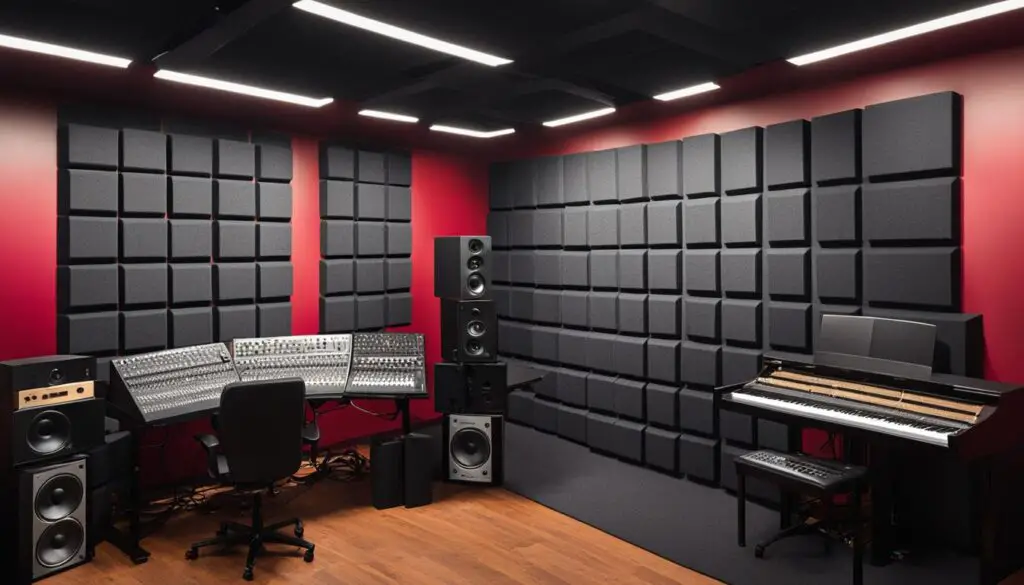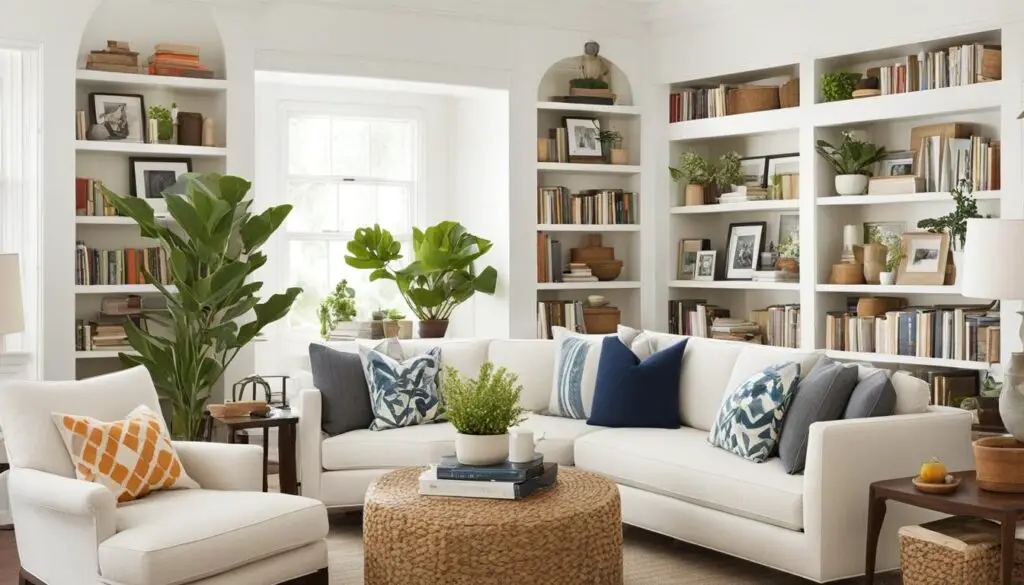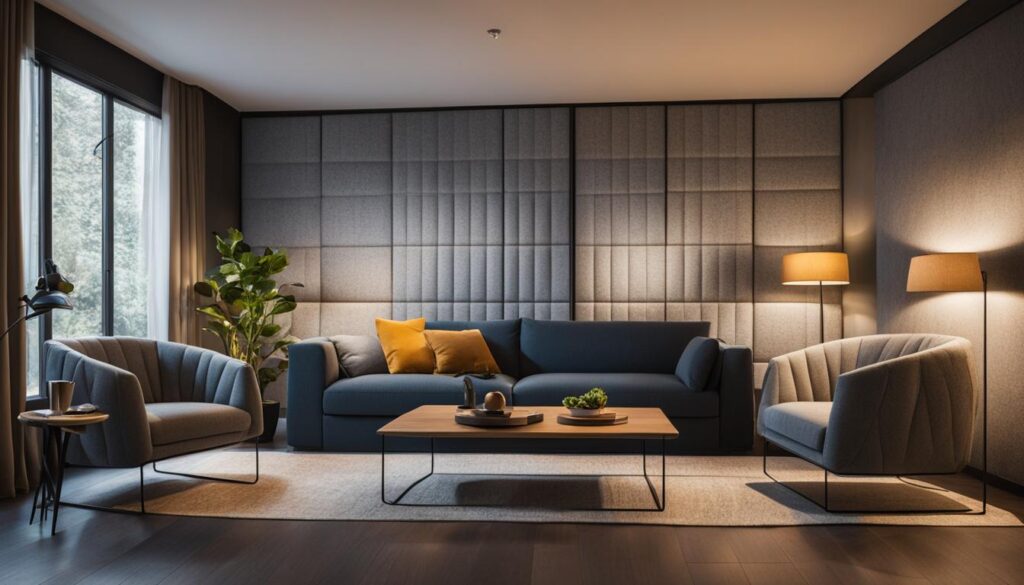Creating a peaceful and quiet environment in your home doesn’t have to be costly. With these cheap and effective soundproofing techniques, you can significantly reduce noise from outside sources and enjoy a serene space on a budget.
When it comes to soundproofing your home, there are several areas to focus on. From assessing and sealing air leaks to rearranging furniture and using acoustic panels, each step plays a crucial role in minimizing noise intrusion. Let’s explore these techniques in detail.
Table of Contents
Key Takeaways:
- Assess and seal air leaks to reduce noise infiltration.
- Install heavy curtains made from dense materials to block noise.
- Use acoustic panels on walls and ceilings to control echo and improve sound quality.
- Rearrange furniture and decor to absorb sound and minimize noise transmission.
- Insulate walls and floors to create a sound barrier and reduce impact noise.
By implementing these affordable soundproofing techniques, you can transform your home into a tranquil haven, free from unwanted noise. Let’s dive deeper into each method and discover how to soundproof your home effectively.
Assess and Seal Air Leaks
One of the first steps in soundproofing your home is to assess and seal any air leaks. Air leaks can be a major source of noise infiltration, allowing external sounds to seep into your living space. By identifying and sealing these leaks, you can effectively reduce noise and create a quieter environment.
The Impact of Air Leaks on Noise
Air leaks act as pathways for sound waves to travel through, allowing noise to easily enter your home. Common areas where air leaks occur include windows, doors, and electrical outlets. Even small gaps can contribute to significant noise infiltration, disrupting your peace and tranquility.
By sealing these air leaks, you not only reduce noise but also improve the energy efficiency of your home. Eliminating drafts and preventing air leakage helps maintain a comfortable indoor temperature, reducing the need for excessive heating or cooling.
“Air leaks in your home can make it difficult to relax and enjoy a quiet environment. By identifying and sealing these leaks, you can create a more serene space, free from disruptive noise.”
Sealing Air Leaks with Weatherstripping and Caulking
To effectively soundproof your home, use weatherstripping and caulking to seal gaps around windows, doors, and electrical outlets. These materials provide a barrier against noise infiltration, preventing sound waves from entering your living space.
Weatherstripping: Use weatherstripping to seal gaps around windows and doors. Choose a weatherstripping material that is durable and weather-resistant to ensure long-lasting effectiveness. Apply it along the edges of windows and doors, creating a tight seal that prevents noise from seeping in.
Caulking: Caulk is an effective way to seal gaps and cracks around electrical outlets. Apply caulking along the edges of the outlet box, filling any openings that might allow noise to enter your home. Ensure that the caulking is applied evenly and smoothly for maximum soundproofing benefits.
https://www.youtube.com/watch?v=xXHeIOEOiAA
| Benefits of Assessing and Sealing Air Leaks | Techniques for Sealing Air Leaks |
|---|---|
| 1. Decreases noise infiltration | 1. Weatherstripping for windows and doors |
| 2. Improves energy efficiency | 2. Caulking for electrical outlets |
| 3. Creates a quieter living space | 3. Ensuring a tight seal |
Install Heavy Curtains
When it comes to soundproofing your home, heavy curtains can be a game-changer. Not only are they affordable, but they also offer excellent sound absorption properties. By choosing curtains made from thick and dense materials, you can effectively block noise from entering through your windows and create a more peaceful environment.
Heavy curtains work by absorbing and dampening sound waves, preventing them from reverberating and echoing in your living space. This not only reduces the amount of noise that enters your home but also helps to create a more acoustically balanced room.
When selecting heavy curtains for soundproofing, look for fabrics such as velvet, suede, or thermal-backed materials. These dense materials provide an additional layer of insulation, making them ideal for blocking out external noise sources.
Aside from their soundproofing benefits, heavy curtains also offer other advantages. They provide privacy, block out unwanted light, and help regulate room temperature by providing an extra layer of insulation.
To make the most of your heavy curtains, ensure that they cover the entire window area, including any gaps on the sides and top. Consider adding blackout liners behind the curtains for added light-blocking and soundproofing benefits. Remember to keep the curtains closed during noisy times of the day to maximize their noise-reducing effect.
Benefits of Heavy Curtains for Soundproofing:
- Improved sound absorption
- Effective noise blockage
- Privacy enhancement
- Light-blocking capabilities
- Enhanced insulation for temperature control
Incorporating heavy curtains into your home decor is a practical and cost-effective way to reduce noise and create a more peaceful living environment. With their sound absorption properties and ability to block noise, heavy curtains can make a noticeable difference in the soundproofing of your home.
Use Acoustic Panels
If you’re looking to enhance soundproofing in your home and reduce echo, acoustic panels can be an excellent solution. These versatile panels are specifically designed to absorb sound and create a more acoustically balanced space. By strategically placing acoustic panels on walls, ceilings, and other surfaces, you can effectively minimize noise and improve sound quality in your home.
Acoustic panels are made from sound-absorbing materials that help reduce sound reflections and control reverberations. They come in various shapes, sizes, and designs, allowing you to choose options that best suit your aesthetic preferences.
Installing acoustic panels is a straightforward process. You can adhere them to the desired surfaces using adhesive or mounting hardware, depending on the panel’s weight and the material of the surface. For maximum effectiveness, it’s essential to identify areas in your home that are particularly prone to noise, such as home theaters or bedrooms, and focus on installing panels in those spaces.

The acoustic panels work by absorbing sound waves and preventing them from bouncing back into the room, thus reducing echo and enhancing overall soundproofing. Not only will this benefit your comfort and tranquility at home, but it can also contribute to better audio experiences, especially in rooms dedicated to entertainment or relaxation.
When selecting acoustic panels, consider factors such as the thickness of the panels and the level of sound absorption they offer. Thicker panels generally provide better sound absorption but may protrude further from the wall. Additionally, textured or patterned panels can add visual interest to your space while still serving their functional purpose.
By incorporating acoustic panels into your soundproofing strategy, you can transform your home into a haven of serenity. Not only will these panels help reduce noise and echo, but they will also enhance the overall aesthetic appeal of your living space.
Benefits of Acoustic Panels:
- Effectively reduce noise levels and echo
- Enhance sound quality in your home
- Add visual interest to your space
- Create a more acoustically balanced environment
- Improves audio experiences in dedicated entertainment areas
Investing in acoustic panels is a worthwhile endeavor if you value peace, quiet, and excellent sound quality in your home. Let these panels work their magic in reducing noise and creating a more harmonious living environment.
| Soundproofing Method | Cost | Effectiveness | Ease of Installation |
|---|---|---|---|
| Acoustic Panels | $$ | ★★★★★ | ★★★☆☆ |
| Assess and Seal Air Leaks | $ | ★★☆☆☆ | ★★★★☆ |
| Heavy Curtains | $ | ★★★☆☆ | ★★☆☆☆ |
| Rearrange Furniture and Decor | $ | ★★☆☆☆ | ★★★☆☆ |
| Insulate Walls and Floors | $$ | ★★★★☆ | ★★★☆☆ |
Rearrange Furniture and Decor
When it comes to soundproofing, the arrangement of your furniture and decor can make a surprising difference. By strategically placing certain items, you can enhance sound absorption and minimize noise transmission within your home.
One effective technique is to place bookshelves against walls. Books and other objects on the shelves act as natural sound absorbers, helping to reduce echo and reverberation in the room. Additionally, consider adding rugs to your floors. Thick and dense rugs can help absorb sound vibrations and minimize noise impact.
Another trick is to position upholstered furniture against the walls. Sofas, armchairs, and padded headboards not only add comfort and style to your space but also contribute to sound absorption. The soft upholstery materials help soak up sound waves, preventing them from bouncing off hard surfaces and creating unnecessary noise.
It’s important to be mindful of placement near noise-prone areas, such as windows. Avoid positioning hard and reflective surfaces, such as glass or metal furniture, in these locations. Instead, opt for softer materials and fabrics that aid in minimizing noise and creating a more peaceful atmosphere.
“By strategically placing certain items, you can enhance sound absorption and minimize noise transmission within your home.”
Consider the following suggestions for furniture and decor arrangements to improve soundproofing:
- Place bookshelves against walls to absorb sound waves.
- Add thick rugs to floors to dampen noise impact.
- Position upholstered furniture against walls to enhance sound absorption.
- Avoid placing hard and reflective surfaces near windows or noise-prone areas.
By implementing these rearrangement techniques, you can create a more acoustically pleasing environment and minimize noise disturbances in your home.

Insulate Walls and Floors
Insulating your walls and floors can greatly enhance soundproofing in your home. When it comes to wall insulation, using materials such as fiberglass or cellulose can effectively fill wall cavities and create a barrier against noise infiltration. These insulation materials absorb sound vibrations, preventing them from passing through walls and minimizing noise transmission.
In addition to wall insulation, don’t overlook the importance of floor insulation in your soundproofing efforts. Adding insulation material between floorboards can help reduce impact noise, such as footsteps or objects being dropped on the floor. Consider using soundproof underlayments or carpet padding to further dampen sound and create a quieter living environment.
When insulating your walls and floors, it’s crucial to follow proper installation techniques and safety guidelines. If you’re unsure about the process, it’s recommended to consult a professional contractor to ensure optimal results.
To visualize the impact of insulation on soundproofing, take a look at the table below:
| Material | Soundproofing Efficiency |
|---|---|
| Fiberglass Insulation | Excellent |
| Cellulose Insulation | Very Good |
| Soundproof Underlayment | Good |
| Carpet Padding | Good |
As you can see from the table, materials like fiberglass and cellulose insulation offer excellent soundproofing efficiency, making them ideal choices for insulating walls. Soundproof underlayment and carpet padding, while not as effective as insulation materials, still provide good sound dampening properties for floors.
Conclusion
By implementing these cheap and effective soundproofing techniques, you can soundproof your home and create a peaceful and quiet environment without breaking the bank. Assessing and sealing air leaks, using heavy curtains, installing acoustic panels, rearranging furniture, and insulating walls and floors are all affordable ways to reduce noise and enjoy a serene living space.
Start by assessing and sealing any air leaks in your home. Use weatherstripping and caulking to seal gaps around windows, doors, and electrical outlets. This will not only help reduce noise but also improve energy efficiency.
Next, install heavy curtains made from thick and dense materials. These curtains provide sound absorption properties and can block noise from entering through your windows. They also add privacy to your space.
Consider using acoustic panels to further reduce noise and control echo in your home. These panels, made from sound-absorbing materials, can be applied to walls, ceilings, and other surfaces. By installing them in noise-prone areas, such as home theaters or bedrooms, you can greatly improve sound quality.
Rearranging your furniture and decor can also have a significant impact on soundproofing. Place bookshelves, rugs, and upholstered furniture against walls to absorb sound and minimize noise transmission. Avoid placing hard and reflective surfaces near windows or other noise-prone areas.
Lastly, insulate your walls and floors. Use insulation materials, such as fiberglass or cellulose, to fill wall cavities and create a barrier against noise. Adding carpet or rugs to your floors can also help dampen sound and reduce impact noise.
With these low-cost soundproofing techniques, you can transform your home into a peaceful sanctuary where noise is minimized, and tranquility reigns.
FAQ
How can I soundproof my home on a budget?
Soundproofing your home can be affordable with these cheap and effective techniques:
How do I assess and seal air leaks in my home?
To reduce noise infiltration, assess and seal air leaks by using weatherstripping and caulking to seal gaps around windows, doors, and electrical outlets.
What can I use to improve soundproofing in my home?
Installing heavy curtains made from thick and dense materials is an affordable way to improve soundproofing. These curtains provide sound absorption properties and can help block noise from entering through windows.
How can acoustic panels help with soundproofing?
Acoustic panels made from sound-absorbing materials can be applied to walls, ceilings, and other surfaces to reduce noise and control echo in your home. Installing them in noise-prone areas like home theaters or bedrooms can significantly improve sound quality.
Can rearranging furniture and decor help with soundproofing?
Yes, rearranging your furniture and decor can have a surprising impact on soundproofing. Placing bookshelves, rugs, and upholstered furniture against walls can absorb sound and minimize noise transmission. Avoid placing hard and reflective surfaces near windows or other noise-prone areas.
How can I insulate my walls and floors for soundproofing?
Insulating your walls and floors can greatly enhance soundproofing. Fill wall cavities with insulation materials like fiberglass or cellulose to create a barrier against noise. Additionally, adding carpet or rugs to your floors can help dampen sound and reduce impact noise.
What are some affordable ways to soundproof my home?
Assess and seal air leaks, use heavy curtains, install acoustic panels, rearrange furniture and decor, and insulate walls and floors are all cheap and effective techniques for soundproofing your home.


